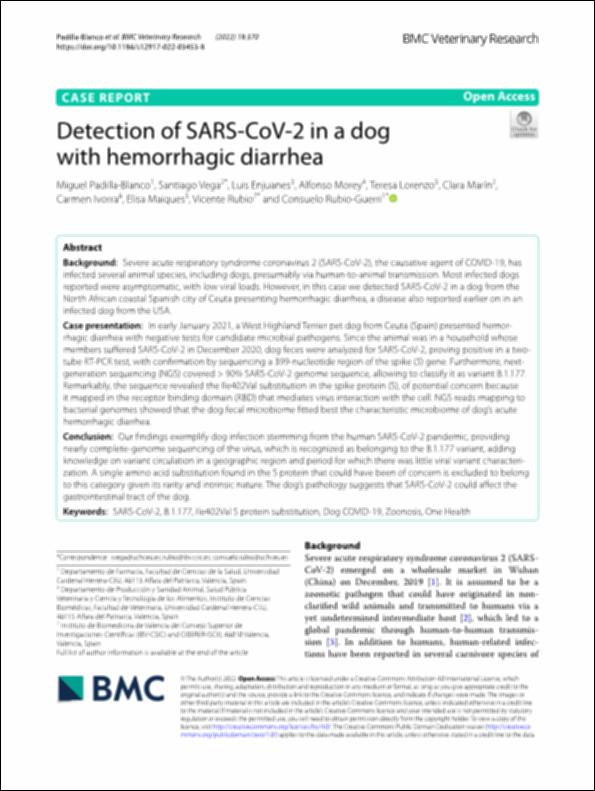Please use this identifier to cite or link to this item:
http://hdl.handle.net/10637/14258Detection of SARS-CoV-2 in a dog with hemorrhagic diarrhea
| Title: | Detection of SARS-CoV-2 in a dog with hemorrhagic diarrhea |
| Authors : | Padilla Blanco, Miguel Vega García, Santiago Enjuanes Sánchez, Luis Morey, Alfonso Lorenzo Bermejo, Teresa Marín Orenga, Clara Ivorra, Carmen Maiques Fernández, Elisa Rubio Zamora, Vicente Rubio Guerri, Consuelo |
| Keywords: | COVID-19.; SARS-CoV-2 (Virus); Zoonosis.; Zoonoses.; Perros - Infecciones por coronavirus.; Dogs - Coronavirus infections.; COVID-19 (Disease) |
| Publisher: | Springer Nature |
| Citation: | Padilla-Blanco, M., Vega, S., Enjuanes, L., Morey, A., Lorenzo, T., Marín, C., Ivorra, C., Maiques, E., Rubio, V. & Rubio-Guerri, C. (2022). Detection of SARS-CoV-2 in a dog with hemorrhagic diarrhea. BMC Veterinary Research, vol. 18, i. 1 (12 oct.), art. 370. DOI: https://doi.org/10.1186/s12917-022-03453-8 |
| Abstract: | Background: Severe acute respiratory syndrome coronavirus 2 (SARS-CoV-2), the causative agent of COVID-19, has infected several animal species, including dogs, presumably via human-to-animal transmission. Most infected dogs reported were asymptomatic, with low viral loads. However, in this case we detected SARS-CoV-2 in a dog from the North African coastal Spanish city of Ceuta presenting hemorrhagic diarrhea, a disease also reported earlier on in an infected dog from the USA. Case presentation: In early January 2021, a West Highland Terrier pet dog from Ceuta (Spain) presented hemorrhagic diarrhea with negative tests for candidate microbial pathogens. Since the animal was in a household whose members suffered SARS-CoV-2 in December 2020, dog feces were analyzed for SARS-CoV-2, proving positive in a twotube RT-PCR test, with confirmation by sequencing a 399-nucleotide region of the spike (S) gene. Furthermore, nextgeneration sequencing (NGS) covered > 90% SARS-CoV-2 genome sequence, allowing to classify it as variant B.1.177. Remarkably, the sequence revealed the Ile402Val substitution in the spike protein (S), of potential concern because it mapped in the receptor binding domain (RBD) that mediates virus interaction with the cell. NGS reads mapping to bacterial genomes showed that the dog fecal microbiome fitted best the characteristic microbiome of dog’s acute hemorrhagic diarrhea. Conclusion: Our findings exemplify dog infection stemming from the human SARS-CoV-2 pandemic, providing nearly complete-genome sequencing of the virus, which is recognized as belonging to the B.1.177 variant, adding knowledge on variant circulation in a geographic region and period for which there was little viral variant characterization. A single amino acid substitution found in the S protein that could have been of concern is excluded to belong to this category given its rarity and intrinsic nature. The dog’s pathology suggests that SARS-CoV-2 could affect the gastrointestinal tract of the dog. |
| Description: | Este artículo se encuentra disponible en la siguiente URL: https://bmcvetres.biomedcentral.com/articles/10.1186/s12917-022-03453-8 |
| URI: | http://hdl.handle.net/10637/14258 |
| Rights : | http://creativecommons.org/licenses/by/4.0/deed.es |
| ISSN: | 1746-6148 (Electrónico) |
| Language: | es |
| Issue Date: | 12-Oct-2022 |
| Center : | Universidad Cardenal Herrera-CEU |
| Appears in Collections: | Dpto. Producción y Sanidad Animal, Salud Pública Veterinaria y Ciencia y Tecnología de los Alimentos |
Items in DSpace are protected by copyright, with all rights reserved, unless otherwise indicated.


